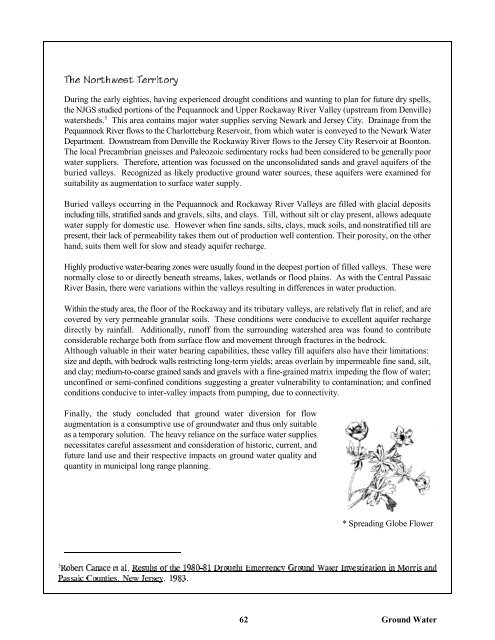A Natural Resource Management Guide for the County of Morris A ...
A Natural Resource Management Guide for the County of Morris A ...
A Natural Resource Management Guide for the County of Morris A ...
Create successful ePaper yourself
Turn your PDF publications into a flip-book with our unique Google optimized e-Paper software.
Northwest The Territory<br />
During <strong>the</strong> early eighties, having experienced drought conditions and wanting to plan <strong>for</strong> future dry spells,<br />
<strong>the</strong> NJGS studied portions <strong>of</strong> <strong>the</strong> Pequannock and Upper Rockaway River Valley (upstream from Denville)<br />
5<br />
watersheds. This area contains major water supplies serving Newark and Jersey City. Drainage from <strong>the</strong><br />
Pequannock River flows to <strong>the</strong> Charlotteburg Reservoir, from which water is conveyed to <strong>the</strong> Newark Water<br />
Department. Downstream from Denville <strong>the</strong> Rockaway River flows to <strong>the</strong> Jersey City Reservoir at Boonton.<br />
The local Precambrian gneisses and Paleozoic sedimentary rocks had been considered to be generally poor<br />
water suppliers. There<strong>for</strong>e, attention was focussed on <strong>the</strong> unconsolidated sands and gravel aquifers <strong>of</strong> <strong>the</strong><br />
buried valleys. Recognized as likely productive ground water sources, <strong>the</strong>se aquifers were examined <strong>for</strong><br />
suitability as augmentation to surface water supply.<br />
Buried valleys occurring in <strong>the</strong> Pequannock and Rockaway River Valleys are filled with glacial deposits<br />
including tills, stratified sands and gravels, silts, and clays. Till, without silt or clay present, allows adequate<br />
water supply <strong>for</strong> domestic use. However when fine sands, silts, clays, muck soils, and nonstratified till are<br />
present, <strong>the</strong>ir lack <strong>of</strong> permeability takes <strong>the</strong>m out <strong>of</strong> production well contention. Their porosity, on <strong>the</strong> o<strong>the</strong>r<br />
hand, suits <strong>the</strong>m well <strong>for</strong> slow and steady aquifer recharge.<br />
Highly productive water-bearing zones were usually found in <strong>the</strong> deepest portion <strong>of</strong> filled valleys. These were<br />
normally close to or directly beneath streams, lakes, wetlands or flood plains. As with <strong>the</strong> Central Passaic<br />
River Basin, <strong>the</strong>re were variations within <strong>the</strong> valleys resulting in differences in water production.<br />
Within <strong>the</strong> study area, <strong>the</strong> floor <strong>of</strong> <strong>the</strong> Rockaway and its tributary valleys, are relatively flat in relief, and are<br />
covered by very permeable granular soils. These conditions were conducive to excellent aquifer recharge<br />
directly by rainfall. Additionally, run<strong>of</strong>f from <strong>the</strong> surrounding watershed area was found to contribute<br />
considerable recharge both from surface flow and movement through fractures in <strong>the</strong> bedrock.<br />
Although valuable in <strong>the</strong>ir water bearing capabilities, <strong>the</strong>se valley fill aquifers also have <strong>the</strong>ir limitations:<br />
size and depth, with bedrock walls restricting long-term yields; areas overlain by impermeable fine sand, silt,<br />
and clay; medium-to-coarse grained sands and gravels with a fine-grained matrix impeding <strong>the</strong> flow <strong>of</strong> water;<br />
unconfined or semi-confined conditions suggesting a greater vulnerability to contamination; and confined<br />
conditions conducive to inter-valley impacts from pumping, due to connectivity.<br />
Finally, <strong>the</strong> study concluded that ground water diversion <strong>for</strong> flow<br />
augmentation is a consumptive use <strong>of</strong> groundwater and thus only suitable<br />
as a temporary solution. The heavy reliance on <strong>the</strong> surface water supplies<br />
necessitates careful assessment and consideration <strong>of</strong> historic, current, and<br />
future land use and <strong>the</strong>ir respective impacts on ground water quality and<br />
quantity in municipal long range planning.<br />
* Spreading Globe Flower<br />
5<br />
4QDGTV%CPCEGGVCN4GUWNVUQHVJG&TQWIJV'OGTIGPE[)TQWPF9CVGT+PXGUVKICVKQPKP/QTTKUCPF<br />
2CUUCKE%QWPVKGU0GY,GTUG[<br />
62<br />
Ground Water


